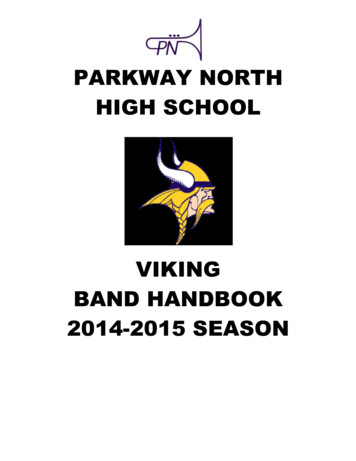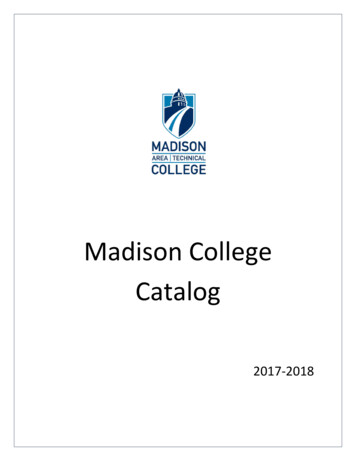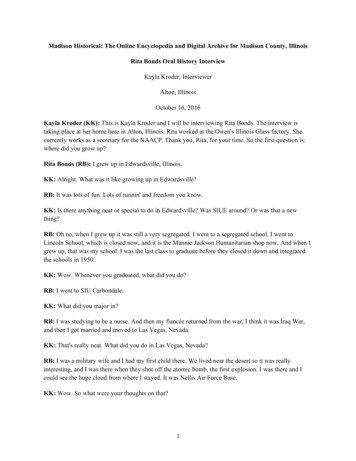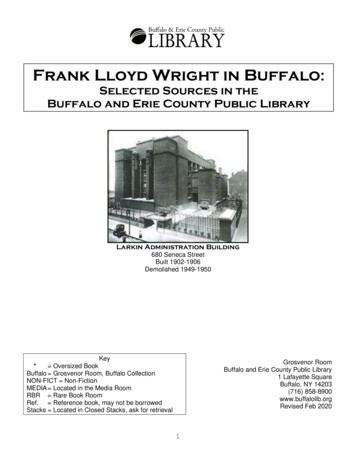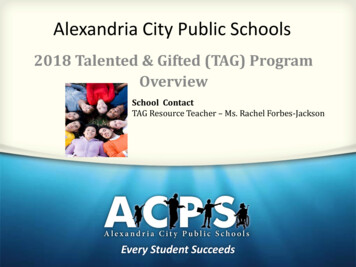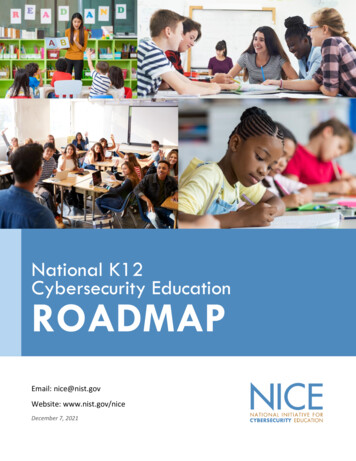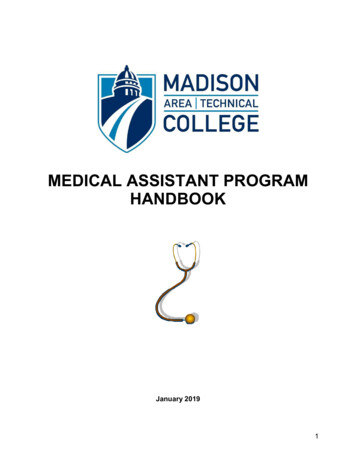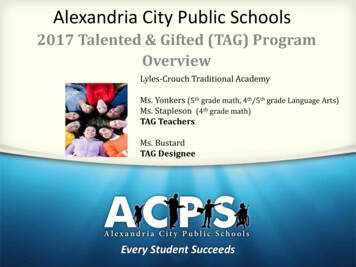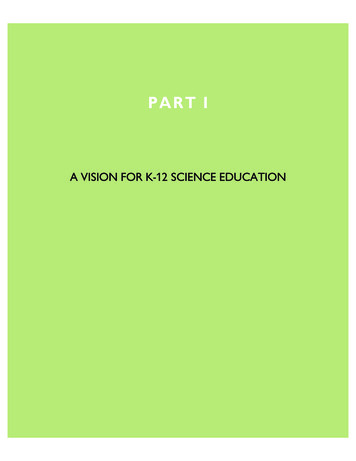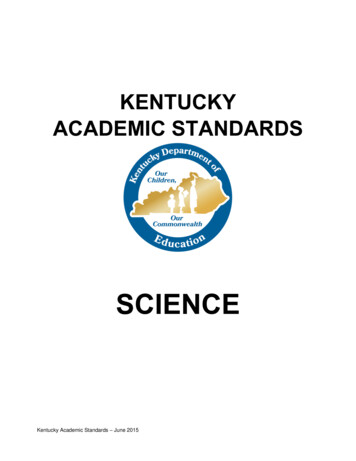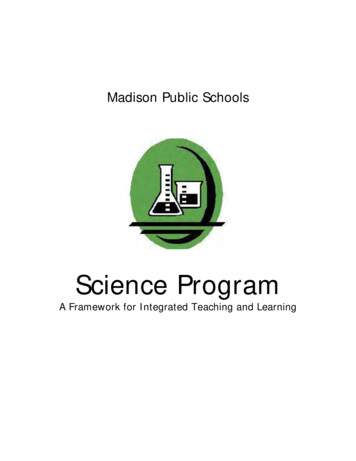
Transcription
Madison Public SchoolsScience ProgramA Framework for Integrated Teaching and Learning
Science ProgramMadison Public Schools10 Campus DriveMadison, CT 06443www.madison.k12.ct.us
Table of ContentsProgram OverviewIntroduction.Structure of Guide .Intent and Acknowledgements .iiiiiiProgram GuideProgram ComponentsPhilosophy .Goals .Design.Enduring Understandings.Conceptual Structure .Benchmarks of Student Progress .Learning Environment .Program Implementation .Program Monitoring and Evaluation .Resources.Appendices .11111222222Program FrameworkVision of Science Education .Vision for Scientific Literacy .Mission of Science Education .Goals for Science Education .The Need for Science Education .Philosophy .Guiding Principles.K – 12 Conceptual Themes and Guiding Questions .55555677Content Standards and Indicators for Scope and Sequence of InstructionElementary SchoolKindergarten .Grade 1 .Grade 2 .Grade 3 .Grade 4 .1527476381Middle SchoolGrade 5 . 105Grade 6 . 123Grade 7 . 141Grade 8 . 161SCIENCE CURRICULUMMADISON PUBLIC SCHOOLS
High SchoolGrades 9 – 12Biology Honors . 199Integrated Science I . 227Integrated Science II . 249Biological Systems. 265General Biology. 293Human Biology . 319Chemistry Honors . 335Chemistry Level 2 . 357AP Chemistry ECE 1127Q. 373AP Physics B ECE 1202 . 391AP Physics C ECE 1401Q. 433Physics Level 2 . 443AP Biology . 465Introduction to Horticulture . 473Topics in Science . 497Biotechnology & Forensic Science . 513Anatomy & Physiology . 533Principles of Ecology . 549Marine Science & Technology . 569Program Implementation: Guidelines and StrategiesInstructional Delivery . 593Instruction Requirements . 593Instructional Time . 594Instructional Technology . 594Student Support . 595Professional Growth . 597Professional Supervision and Evaluation . 598Implementation . 598Program Monitoring and EvaluationProgram Monitoring and Evaluation . 601ResourcesSafety . 605Laboratory Procedures . 607MSDS . 610Web Resources . 613Curriculum Improvement Plan Worksheet . 614Template for Unit Plan Overview . 615Works Consulted . 616AppendicesScientific Process Skills for Elementary Students . 619Rubric for Scoring Elementary Science Projects . 621Rubric for Scoring Elementary Science Experiment Report . 623Laboratory Report Form for Middle School Students . 625Rubric for Scoring Curriculum Embedded High School Laboratory Investigations . 629Sample End of Course Tests . 630Framework for 21st Century Learning . 631SCIENCE CURRICULUMMADISON PUBLIC SCHOOLS
PROGRAM OVERVIEWIntroductionThe Madison Curriculum Renewal Process addresses the need for the continual improvement and / orupdating of the schools’ instructional programs through the periodic re-examination of curriculum. Theprocess is recursive and usually occurs within the same cycle as the Board of Education's Framework forStrategic Planning. The full cycle includes fourteen steps.The Science committee has completed the eight steps of curriculum renewal. After review of thecurriculum by the Administrative Council, the Superintendent of Schools and the Board of Education, thesteps of implementation, program monitoring and evaluation will be initiated.Science teachers examined many resources including state and national standards and frameworks forScience learning as well as science curricular programs nationwide. The articulation of the guide’s goalsand standards across grade levels has been examined carefully and has been achieved to the satisfactionof the Science committee charged with the development of the guide. The committee believes that theMadison Public School System has developed a quality Science program that is planned, ongoing, andsystematic.David J. Klein,SuperintendentSCIENCE CURRICULUMAnita L. Rutlin,Assistant SuperintendentiMADISON PUBLIC SCHOOLS
PROGRAM OVERVIEWStructure of the Program GuideThe guide is organized into six (6) sections. This overview section provides direction for understandingthe contents of the guide.The Components and Framework sections provide descriptions of the program components, includingsuch elements as philosophy, goals, design and understandings.The Standards and Indicators for Scope and Sequence of Instruction section states the scope (breadthand depth) of subject content and sequence (order of presentation) to master the subject withunderstanding – to acquire knowledge and skill for handling key tasks in science. It is the overall logic forlearning: 1) a design that is back loaded from expected performances; 2) application of the contentbased on clear performance goals; and 3) a sequence that enables learning and then proficientperforming. Objectives have been identified for grade levels and / or for courses. Objectives for learnersintroduced at earlier grade levels may not be restated at later grade levels, even though periodicreinforcement occurs. The curriculum facilitates learning content incrementally, progressing by tacklingincreasingly complicated ideas and aspects of proficient performance.The Program Implementation: Guidelines and Strategies section provides guidelines and strategies forimplementing the curriculum described in the preceding sections of the guide. This includes descriptionsof various components of instruction -- delivery, requirements, time, technology, student support -- aswell as professional growth and development plus coordination, supervision and evaluation.The Program Monitoring and Evaluation section provides guidelines and procedures for assessing theoverall effectiveness of the curriculum program. There are recommendations for annual programmonitoring and questions to frame program evaluation.The Program Resources section includes Science Safety Manuals for Elementary, Middle and High Schooluse as well as a guide for Scientific Process Skills for elementary students. Also included are instructionalwebsites and the works consulted in creating the program guide.The Appendices follow and include references to the Connecticut Core Science Curriculum Frameworkand Standards, National Science Education Standards, and the Framework for 21st Century Learning thatprovides the foundation to insure that the science learning is current and appropriate to the needs of the21st century.SCIENCE CURRICULUMiiMADISON PUBLIC SCHOOLS
PROGRAM OVERVIEWIntent and AcknowledgmentsThe Science Curriculum Committee believes that students should become confident in their skills andrealize the value of science education as they progress through a challenging curriculum that stressesscientific reasoning and inquiry skills.Science FacultyDaniel Hand High SchoolWalter C. Polson Middle SchoolDr. R.H. Brown Middle SchoolFrank BalanticPaulErica BirdsallBrowneMichael DockerLisa EdgertonBill EdwardsPaula FilipponeJohn GaskellPaul Mezick, Dept. ChairKatherine O’NeilMary O’SullivanChristie PeperatoDavid RussoSteve SekulaSarah TibbettsMarianne ValleyChris WalkerElisa BrakoKathleen Brooks, Prog. CoordinatorCatherine Cyr-SinicropeDavid D’AlessioDianna FloydElizabeth JohnsonDale KukuckaMaud MooreJennifer PackeviczEric AmblerMelinda ArestaKathleen Brooks, Prog. CoordinatorRachel LeonardLaurine MooreFred MuzerNicole SypherDeb ThomasIsland AvenueRyersonJeffreyJennifer FigurelliClare Pinski*Lisa SealesGrade 2 Christine AckermanErin Chester*Alicia Dunbar*Jennifer MaxwellGrade 3 Scott MongilloErin SmithLynn VoitansCatherine Williams*Grade 4 M. Peggy Bell*Laleh KarimiEileen MartinKelly OttTina PerryGrade 1Toby AndrewsRenee Pardo*Tara VitaleGrade 2 Maria BarnikowJeanette IacobellisDeana Perillo*Julie WeberGrade 3 Alicia DeNuzzoMichelle HornFran ManganelloAlisha Signore *Laura TannerGrade 4 Carissa Connell*Michael GinsburgJane KrausRoberta OtisMath Specialist* Science LiaisonGrade 1SCIENCE CURRICULUMGrade 1iiiDenise ChabotDebbie LynchMichelle RindfleischJean Stewart *Bethany Taylor*Grade 2 Mary Ellen BabikCindi GardnerChrista LaragyAshley Lunn*Stacey Ritsick*Grade 3 Esther MageeDiane Powers*Tracey RossiMichelle Schmidt*Pam WhalenGrade 4 Lisa CaldwellLisaCinquinoCaldwellEllaJennifer Hall Pflomm*John PluchinoTracey SoboleskiMADISON PUBLIC SCHOOLS
PROGRAM OVERVIEWSCIENCE CURRICULUMivMADISON PUBLIC SCHOOLS
ProgramGuide
PROGRAM GUIDE
PROGRAM GUIDEProgram Component DescriptionsPhilosophyAn effective curriculum design needs to incorporate a philosophy, i.e., a statement of beliefs. The philosophyreflects national trends based on research and effective practice. It also incorporates the school district’sbeliefs regarding the content area. Research studies, curriculum frameworks, and assessment arereferenced. An effective philosophy mirrors a vision statement and prepares the system to meet the needs ofits students for the 21st century.GoalsGoals address what students should know and be able to do after experiencing a quality curriculum ingrades K-12. Connecticut’s Common Core of Learning states that all educated citizens must possess a core ofbasic enabling skills and competencies that provide the critical intellectual foundations for broader acquisitionof knowledge. Goals that are established for Science explain those given competencies.DesignUnderstanding by Design or UbD is a framework developed by Grant Wiggins and Jay McTighe and publishedby the Association for Supervision and Curriculum Development. It is a tool for educational planning focusedon ―teaching for understanding.‖ The emphasis of UbD is on ―backward design,‖ the practice of looking atoutcomes in order to design curriculum units, performance assessments and classroom instruction. Theteacher starts with the classroom outcomes and then plans the curriculum, prepares assessments that helpdetermine student mastery, and chooses activities and materials that foster student learning.UbD expands on ―six facets of understanding‖, which include students being able to explain, interpret, apply,have perspective, empathize, and have self-knowledge about a topic. ―Teaching for Understanding‖ shouldbe evident in course design, teacher and student attitudes, and the classroom learning environment. Thereshould be systematic curriculum design with distinctions between the enduring understandings and essentialquestions. Students should be familiar with the essential questions, performance requirements, andevaluation criteria at the beginning of each unit or course.Enduring UnderstandingsUnderstandings are characterized as: Statements that summarize insights that students are expected to remember. Inferences that students must draw, realize, or grasp, based on learning. Insights that link facts and skills to ―big ideas‖ in meaningful ways that are related to the ―real world‖.Conceptual StructureThe science framework is organized around eleven conceptual themes and guiding questions in the earth,life and physical sciences. Each theme is addressed by several content standards that spiral through thegrades, each time being treated with greater depth and breadth, in accordance with developmentalappropriateness for the students.SCIENCE CURRICULUM1
PROGRAM GUIDEBenchmarks of Student ProgressBenchmarks include identified assignments and assessments that serve as markers for incremental studentprogress at different points in a grade level or course.Learning EnvironmentThe learning environment addresses the ambiance in which the students work. It is an environment whichencourages active participation through listening, watching, speaking, reading, and writing. It describes thescience classroom / lab where the student’s engagement, understanding, and development of process andinquiry skills are nurtured.Program ImplementationThe implementation section will be dynamic. As the curriculum is available electronically, changes andupdates will be ongoing. Recent revisions to the grade level expectations in the Connecticut K-8 ScienceCurriculum Standards in the Connecticut Core Science Framework have had a subsequent effect on thecurriculum.The focus of implementation includes instructional delivery, requirements, time, and technology. Professionaldevelopment, supervision and evaluation facilitate implementation.Program Monitoring and EvaluationProgram Evaluation addresses the effectiveness of the program from a student performance stance. Theeffectiveness of the designated curriculum is determined by whether the students are progressively gainingproficiency in science as evidenced by benchmark assignments and assessments, unit and course tests,Connecticut Mastery Tests, and Connecticut Academic Performance Tests.ResourcesThe Resources section includes Science Safety Guides for Elementary Science Safety, Middle School ScienceSafety, and High School Science Safety as well as websites and works consulted in the development of thisdocument.AppendicesThe appendices contain reference materials such as the Connecticut Core Science Curriculum Framework,National Science Education Standards, and the Framework for 21st Century Skills.SCIENCE CURRICULUM2
ScienceProgram Framework
PROGRAM FRAMEWORK
PROGRAM FRAMEWORKVision of Science Education: A quality science education fosters a population that: Experiences the richness and excitement of knowing about the natural world and understanding howit functions.Uses appropriate scientific processes and principles in making personal decisions.Engages intelligently in public discourse and debate about matters of scientific and technologicalconcern.Applies scientific knowledge and skills to increase economic productivity. Vision for Scientific LiteracyGlobal interdependence, rapid scientific and technological innovation, the need for a sustainableenvironment, economy and society, and the pervasiveness of science and technology in daily life reinforcethe importance of scientific literacy. Scientifically literate individuals can more effectively interpretinformation, solve problems, make informed decisions, accommodate change and create new knowledge.Science education is a key element in developing scientific literacy and in building a strong future forMadison's students.Scientific literacy is an evolving combination of the science-related attitudes, skills and knowledge studentsneed to develop inquiry, problem-solving, and decision-making abilities, to become lifelong learners, and tomaintain a sense of wonder about the world around them. Learning experiences based on standards andexpectations will provide students with many opportunities to explore, analyze, evaluate, synthesize,appreciate and understand the interrelationships among science, technology, society and the environmentthat will affect their personal lives, careers and future.Mission of Science EducationScientifically literate students posses the knowledge and understanding of scientific concepts and processesrequired for personal decision-making, participation in civic and cultural affairs and economic productivity.Goals for Science EducationTo promote scientific literacy, science education will encourage students at all grades to develop a critical sense of wonder and curiosity aboutscientific and technological endeavors.enable students to use science and technology to acquire new knowledge and solve problems, sothat they may improve the quality of their own lives and the lives of others.prepare students to critically address science-related societal, economic, ethical and environmentalissues.provide students with a proficiency in science that creates opportunities for them to pursueprogressively higher levels of study, prepares them for science-related occupations, and engagesthem in science-related activities appropriate to their interests and abilities.develop in students of varying aptitudes and interests a knowledge of the wide variety of careersrelated to science, technology and the environment.The Need for Science Education―In this changed world, knowledge of math and science is paramount.‖ (U.S. Department of Education.2006) It is essential that students are taught the skills necessary to compete and succeed in highereducation and the workforce. The study and ―work of science relies on basic human qualities such asreasoning, insight, energy, skills and creativity – as well as on scientific habits of mind, such as intellectualhonesty, tolerance of ambiguity, skepticism, and openness to new ideas.‖ (National Science Standards)SCIENCE CURRICULUM5
PROGRAM FRAMEWORKPeople of both genders and of all social and ethnic backgrounds with diverse talents engage in activities ofscience including engineering, research and health professionals and related fields. Scientists in all fieldsmay work in teams or alone but they must communicate extensively with others. For progress in science,the exchange of ideas, information, data and materials is essential. This communication goes well beyondresearch facilities or universities crossing national boundaries and spanning the globe. Therefore, thedevelopment of good communication skills is needed in addition to inquiry skills including the forming of ascientific question, the testing of a hypothesis, designing and performing a valid experiment, collecting validand useful data, analyzing data, and drawing conclusions.PhilosophyTo promote scientific literacy, it is crucial to recognize how students learn, how science can best be taught,and how learning can be assessed. Students are curious, active learners who have individual interests,abilities and needs. They come to school with various personal and cultural experiences and prior knowledgethat generate a range of attitudes and beliefs about science and life.Students learn most effectively when their study of science is rooted in concrete learning experiences,related to a particular context or situation, and applied to their world. The ideas and understandings thatstudents develop can be progressively extended and reconstructed as students grow through theirexperiences and in their ability to conceptualize. Learning involves the process of linking newly constructedunderstandings with prior knowledge and adding new contexts and experiences to current understandings.Development of scientific literacy is supported by instructional environments that engage students in theprocesses of scientific inquiry: students address questions about natural phenomena, involving explorations aswell as focused investigations.technological problem solving (design process): students seek answers to practical problemsrequiring the application of their science knowledge in various ways.decision making: students identify issues and pursue science knowledge that will inform the issues.It is through these processes that students discover the significance of science in their lives and come toappreciate the interrelationships of science, technology, society and the environment.Each of the processes is a potential starting point for approaching science learning. These processes mayencompass a variety of learning approaches for exploring new ideas for development specific investigationsand for applying the ideas that are learned.To achieve the vision of scientific literacy, students must increasingly become engaged in the planning,development and evaluation of their own learning experiences. They should have the opportunity to workcooperatively with other students, to initiate investigations, to communicate their findings, and to completeprojects that demonstrate their learning. To assist teachers in planning for instruction, assessment,evaluation and reporting, science teachers recommend: At the beginning of each unit of instruction, the expected student learning outcomes andperformance criteria are identified. It is important that the student learning outcomes andperformance criteria correspond with state and national standards and expectations. Thecommunication between students and teachers helps to clearly establish what needs to beaccomplished, thereby assisting in the learning process.When students are aware of expected outcomes, they will be more focused on the essentiallearning and more likely to assess their own progress. Furthermore, they can participate inassessment as learning to meet expectations. Assessment must be valid, reliable and fair tostudents.SCIENCE CURRICULUM6
PROGRAM FRAMEWORKGuiding PrinciplesGuiding principles form the basis of an effective science education program. They address the complexity ofthe science content and the methods by which science content is best taught. They clearly define theattributes of a quality science curriculum at the elementary, middle, and high school levels.Effective science programs: are based on standards and use standards-based instructional materials. develop students’ command of the language of science used in the standards. reflect a balanced, comprehensive approach that includes the teaching of inquiry along with directinstruction and reading. use multiple instructional strategies and provide students with multiple opportunities to master thestandards. include continual assessment of students’ knowledge and understanding. engage all students in learning and prepare and motivate students for further instruction inscience. use technology to teach students, assess their knowledge, develop information resources, andenhance computer literacy. have adequate instructional resources as well as library-media and administrative support. use standards-based connections with other core subjects to reinforce science teaching andlearning.K-12 Conceptual Themes and Guiding (Essential) QuestionsThe conceptual themes and the guiding questions together with the content standards and grade level expectationscontribute to students' abilities to have enduring understandings and to respond to the guiding (essential) questions.Properties of MatterHow does the structure of matter affect the properties and uses of materials? Properties of Objects (K) Properties of Materials (2) States of Matter (3) Elements, Compounds and Mixtures (6) Chemical Reactions (9) Carbon Compounds (9)Energy Transfer and TransformationsWhat is the role of energy in our world? Electricity and Magnetism (4) Physics of Sound (4) Light (5) Energy and Work (7) Energy Conservation and Transformation (9) Electrical Forces
The Appendices follow and include references to the Connecticut Core Science Curriculum Framework and Standards, National Science Education Standards, and the Framework for 21st Century Learning that provides the foundation to insure that the science learning is
